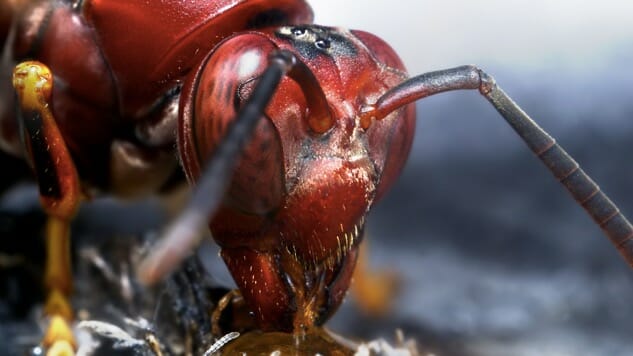From Alabama to Colombia: Big-Ass Ants Don’t Taste Like Chicken

Paste reader, I am about to eat—real-time, right now, as you read—a big-ass ant. And I’m going to tell you exactly how a big-ass ants tastes, chews, smells and goes down the gullet.
We buy Hormigas culonas, literally “big-ass ants,” in Bogotá from aggressive street vendors. They rush cars at stop lights and push plastic bags of big-ass ants through open windows while they yell “big-ass ants!” at drivers.
The logo on the bags displays a smiling queen ant with a big ass and a yellow crown. She waves hello with one limb. With her others, the big-ass queen strides like an Olympic speed-walker, clearly going places. Crawling the plastic package are repeated advertising words deliciosas deliciosas deliciosas etc., and elsewhere, in bright red letters, Pruébame! (Try me!) The big-ass ant pack also carries a health advisory … Proteinas! Nutritivas! (Protein! Nutrients!) … and the word Santandereanas. This means big-ass ants come from Santander, a Colombian state best known for tough women, but also for big-ass ants.
The kicker? The package bears a green badge with white lettering: “100% NATURAL”. A buyer can be sure he’s getting 100-percent natural ants. Not artificial big-ass ants, with Stevia or MSG or genetic modification. No, señor. It’s 100-hundred percent natural ants with real big asses. Nothing less.
My bogotana family proudly presented me, their constantly amusing gringo, with my first-ever package of edible ants. It occurs to me at this writing that I must be as hilarious to these Colombians as Sofia Vergara is to her modern U.S. TV family. Legends are born here on days I mistake a bar of soap for a piece of tasty Colombian cheese. Or when I ask at breakfast, in my best Spanish, for testicles instead of eggs.
After graciously receiving my special gift, I crawled around the internet doing a little research. I like to know my food before I gnaw my food. It turns out people in South America have been eating Atta laevigata, the big-ass ant, for centuries. This variety of tropical leafcutter takes a nuptial flight in rainy season. The poor schmucks who harvest these flying creatures get bitten a lot—big-ass ants have big mandibles too. But it’s worth it to collect the majestic queens, with their fantastic steatopygiac endowments, to fill colorful packages sold on Bogotá street corners. The captured queens first have their wings plucked … then, sad as Anne Boleyn, they get soaked, salted, and roasted.
Local legends ascribe aphrodisiac powers to big-ass ants, and a bride and groom in Santander might receive ants as a wedding gift. (I’m thinking big-ass ants would look pretty cool sprinkled over a white wedding cake.) According to Wikipedia, the Industrial University of Santander tested big-ass ants for nutritional value. They turn out to be health food—virtually fat-free, with very high levels of protein and lots of roughage.
Still, one rightly asks, how do they taste? And that brings us, Paste reader, to the magic moment.
Full disclosure: I have eaten an ant before. More than once.
No kid grows up in Alabama without, at some unexpected moment, crunching down on a fire ant that has flown or crawled or fallen or hatched or in some occult manner mysteriously appeared from nowhere on a sandwich or a deviled egg or a honeybun or a Vienna sausage or a chitlin or just, ouch!, exploding on your tongue like a taste bud gone ISIS.
Fire ants, as you might guess, taste hot. Formic acid burns, and then burns some more. Fire ants have devised a very creative way to keep other creatures from eating them. You bite one, then you hear something in your head not unlike a guitar string breaking, then pain comes rolling down like a mighty river.
-

-

-

-

-

-

-

-

-

-

-

-

-

-

-

-

-

-

-

-

-

-

-

-

-

-

-

-

-

-

-

-

-

-

-

-

-

-

-

-








































